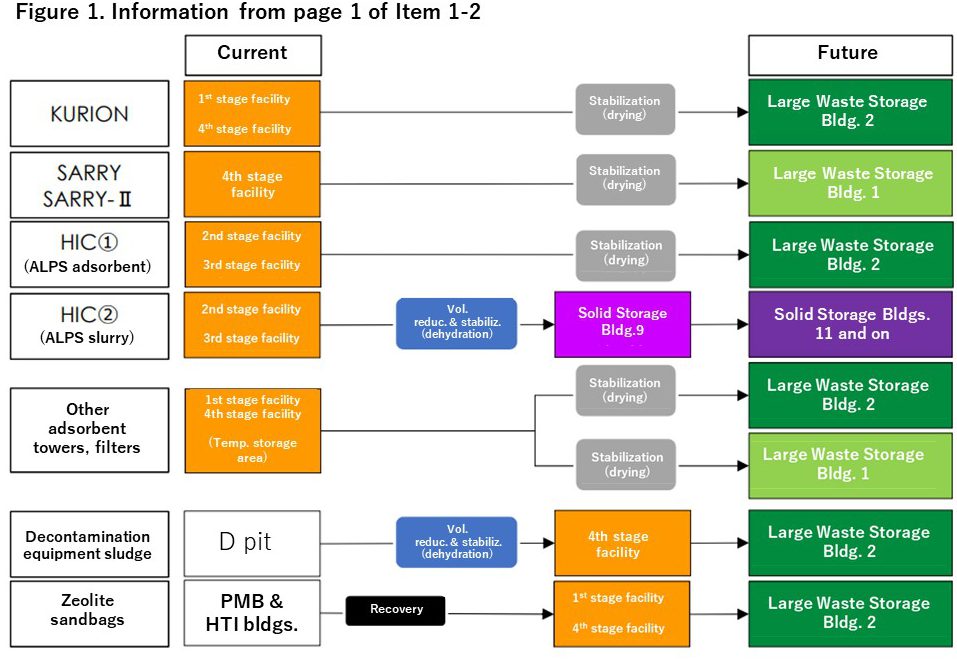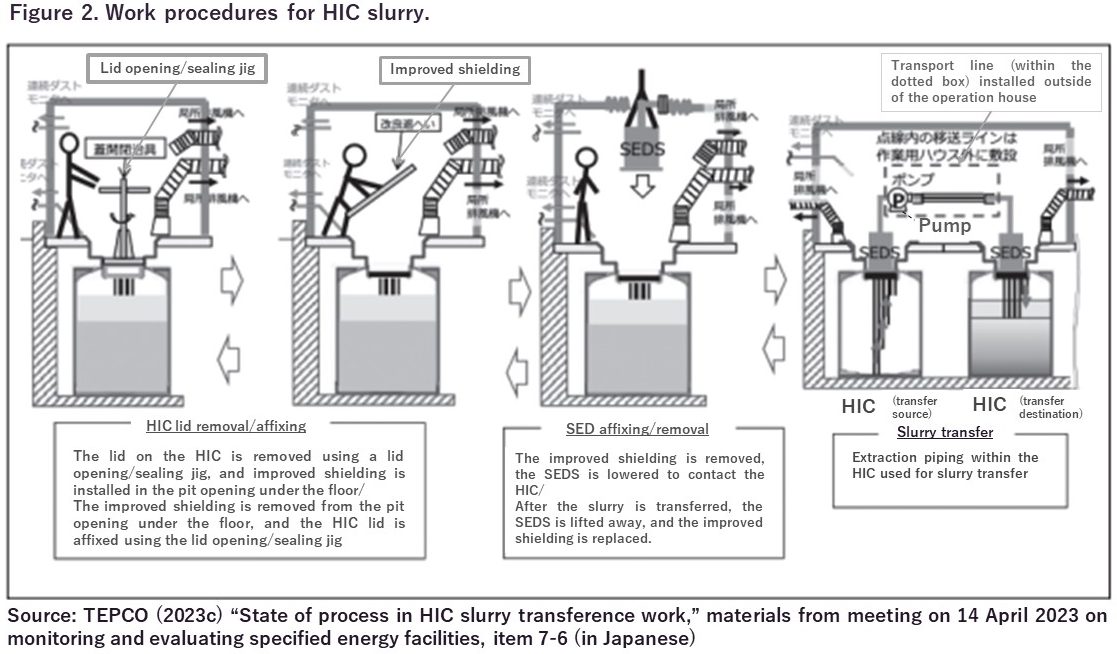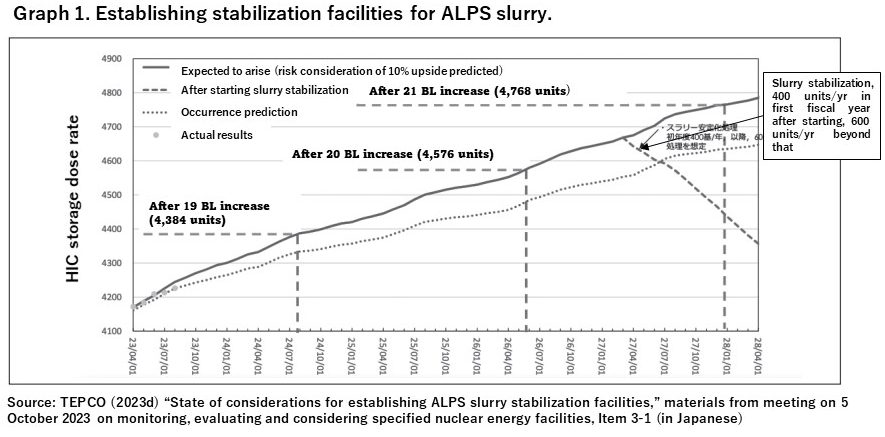Overview of Water Treatment Secondary Waste Issues at the Fukushima Daiichi Nuclear Power Plant
By Masano Atsuko
Work to clear up the mess from the accident at Fukushima Daiichi Nuclear Power Plant (below, Fukushima Daiichi) operated by Tokyo Electric Power Company Holdings, In. (below, TEPCO) has run into severe difficulties. The treatment of waste generated in the course of treating contaminated water (below, “secondary waste from water treatment”) is no exception. Here, I attempt to provide an overview of these issues. I recommend referring to Fig. 1 and Table 2 while reading this.
- What Wastes are They Keeping Where?
(1) Secondary Waste from Water Treatment Generated Directly After the Accident and Left in Situ
Secondary waste from water treatment generated directly after the accident is being stored in the Process Main Building (PMB) and High-Temperature Incinerator (HTI) building on the platform at 8.5 m elevation above sea level on the south side of Fukushima Daiichi Unit 4. Prior to the accident, these two buildings were being used to store radioactive waste items temporarily and reduce their volume (through incineration). After the accident, equipment by the name of “SARRY” was installed in the latter, which, as a result of a valve-operation error, caused leakage of contaminated water.
Decontamination equipment sludge: The highly concentrated sludge generated by the operation in June through September 2011 of the decontamination equipment manufactured by Areva remains in Storage Tank D in the basement of the PMB. In September 2018, its ports and through-holes were closed off as a tsunami countermeasure, as there was a risk of efflux to the ocean. However, since this was not a water-tight building to begin with, the contents were scheduled to be transferred after recovery, dehydration and container stabilization to a large waste item storage vault out of reach of tsunamis (a platform at 33.5 m elevation; below, “high ground”). The recovery was to be completed by FY2025, but radioactivity was confirmed in the tera-becquerel range from strontium-90, and a lot of time has been needed for designing a dust confinement function. Once recovery begins, it is expected to take until at least 2027.
Zeolite sandbags:  Zeolite sandbags (see Table 1) were brought in to purify stagnant water with high concentrations of contaminants that was pooling underground in the second basement of the PMB and under the HTI building, and those have been kept as they are. A maximum dose rate of 4,400 mSv/h has been confirmed there, but the sandbags have deteriorated, and cannot be recovered with the bags intact. Consideration is being given to pumping them out together with the stagnant water and enclosing it all in containers. Methods for collecting the sludge that will undoubtedly remain at the bottom after the sandbags have been retrieved will be considered in the future. This may also be transferred to the high ground and stored there in the future, but that is a matter for future discussion.
Zeolite sandbags (see Table 1) were brought in to purify stagnant water with high concentrations of contaminants that was pooling underground in the second basement of the PMB and under the HTI building, and those have been kept as they are. A maximum dose rate of 4,400 mSv/h has been confirmed there, but the sandbags have deteriorated, and cannot be recovered with the bags intact. Consideration is being given to pumping them out together with the stagnant water and enclosing it all in containers. Methods for collecting the sludge that will undoubtedly remain at the bottom after the sandbags have been retrieved will be considered in the future. This may also be transferred to the high ground and stored there in the future, but that is a matter for future discussion.
(2) Secondary Waste from Water Treatment Generated in the Course of Processing Contaminated Water
Fuel debris that melted and fell into the basement of the reactor buildings comes into contact with inflowing groundwater, resulting in a continually increasing amount of contaminated water. To deal with that, the contaminated groundwater has been put through cesium-adsorption equipment to remove cesium and strontium radionuclides, then through desalination equipment, then through a multi-nuclide removal facility (ALPS) that removes 62 radionuclide species. Aside from tritium, the contaminants are to some degree strained out through adsorbent materials or otherwise removed, and in the course of doing that secondary waste from water treatment is generated. From TEPCO (2023b) “Policy for considering solidification of secondary waste from water treatment” (data from technical meeting to review plans for implementing specified nuclear facilities, 4 December 2023, Item 1-2, in Japanese), I will excerpt information on where the waste, including from (1) above, is currently located, how TEPCO intends to treat it, their policy on where it will be stored in the future (Fig. 1) and the amounts of wastes (Table 2).
 The cesium-adsorption system consists of three types of devices. the primary adsorption tower “KURION,” a secondary cesium adsorption tower called the “SARRY,” and a tertiary cesium adsorption tower, “SARRY II.” After these cesium adsorption towers have been spent, currently consisting of 779 KURIONs, 257 SARRYs and 17 SARRY IIs, they are placed in box culverts and kept in a temporary storage facility (high ground on the south side of Unit 4). The KURION is also being used as a back-up facility for the SARRY, so the number of spent cesium–adsorption towers will not increase further, but the number of SARRYs and SARRY IIs is increasing together with the treatment of contaminated water.
The cesium-adsorption system consists of three types of devices. the primary adsorption tower “KURION,” a secondary cesium adsorption tower called the “SARRY,” and a tertiary cesium adsorption tower, “SARRY II.” After these cesium adsorption towers have been spent, currently consisting of 779 KURIONs, 257 SARRYs and 17 SARRY IIs, they are placed in box culverts and kept in a temporary storage facility (high ground on the south side of Unit 4). The KURION is also being used as a back-up facility for the SARRY, so the number of spent cesium–adsorption towers will not increase further, but the number of SARRYs and SARRY IIs is increasing together with the treatment of contaminated water.
There are three types of ALPS facilities, initial ALPS, added ALPS and high-performance ALPS. The initial and added ALPS facilities perform multi-nuclide removal after a pretreatment. The pretreatment involves injection of a chemical agent that produces a “slurry” consisting of a viscous mixture of fine precipitated matter in the water. The multi-nuclide removal generates “used adsorbent” by straining out the radioactive matter. High-performance ALPS, on the other hand, involves no pretreatment, with the adsorption tower itself replaced, but it is currently not in use. The ALPS slurry has been confirmed to have a maximum dose rate of 13.72 mSv/h at the HIC-side surface. It is stored in polyethylene containers called “high integrity containers” (HIC), which are housed in concrete containers that function to shield the radiation as well as release the heat and hydrogen that are generated, but this comes with two risks.
The first is the risk that chemical decomposition caused by the radioactive substances in the slurry could generate hydrogen gas, increasing the water pressure and causing it to leak. As a countermeasure, TEPCO has been considering reducing the volume of water injected into the HICs, and if any HIC is judged as being too full, letting out some of the water from the HIC. A test run using real slurry is scheduled to be conducted in FY2024.
The second risk is deterioration of the HICs themselves from the radiation. For that reason, there are plans to transfer the HICs, which have been found to exceed a cumulative absorbed dose of 5,000 kGy, to reduce the risk of leakage. For example, of the 102 units evaluated to exceed 5000 kGy by the end of March 2023, 45 had been transferred as of the end of FY2022. Fifty-seven are expected to have been transferred by the end of FY2023. From FY2024 onward, there are plans to transfer 23 units, then 26 units, then 48 units gradually year-by-year. A look at the diagram illustrating the procedure, however, shows it to be work accompanied by risk of exposure (Fig. 2).
After this risky storage work is completed, the slurry is eventually scheduled to be extracted, dehydrated, solidified, transferred to a metal container and stored near the center of the Fukushima Daiichi premises, on the inland side (Solid Storage Bldg. 9).
Used adsorbent material from ALPS is also stored in HICs.
- TEPCO’s Storage Management Policy
To reduce storage risks from all of these varieties of secondary waste from water treatment, TEPCO has established the following policies:
・Promoting transference to storage within buildings.
・Reducing volume through drying and dehydration, decreasing the risk of corrosion and leakage.
・From the standpoint of risks in storage and ensuring storage space, putting higher priority on ALPS slurry, ALPS adsorbent material and decontamination equipment sludge, and taking measures to deal with them.
・A form of storage is chosen that gives consideration to retrieving the waste from the containers later, and processing it prior to solidifying it, without problems arising such as with processing the empty containers.
- Ensuring Storage Space for HICs
It is important to secure storage for the HICs, so 19 plots (for 4,384 units) have been secured to the south of Unit 4 on the inland side. As of the end of FY2022, 4,161 of the spaces were occupied, so the number is to be increased to 4,768 spaces by January 2028 and new plots are expected to be secured elsewhere, capable of holding a maximum of 5,344 units. Meanwhile, with dehydration proceeding, the number of HICs in storage is optimistically expected to decrease (see Graph 1.) It is unknown whether this will go as planned, however. The scarcity of space for contaminated water tanks has been relieved with the oceanic release of tritium water, but if the amount of contaminated water being processed continues to increase, there is no guarantee that space for storing HICs will not become an issue in the future.
It is unknown whether this will go as planned, however. The scarcity of space for contaminated water tanks has been relieved with the oceanic release of tritium water, but if the amount of contaminated water being processed continues to increase, there is no guarantee that space for storing HICs will not become an issue in the future.
- Solidification to Begin No Sooner than 2035
Currently, TEPCO has decided on the following policies regarding solidification of secondary waste from water treatment:
・Formulating policies aiming for sharing facilities, including for debris and other items.
・Taking an approach to processing waste materials, including secondary waste from water treatment as shown in Graph 2. That is to say, with the concentration of βγ nuclides as the horizontal axis and the concentration of α nuclides and others with long half-lives as the vertical axis (lower left on graph), wastes having low concentrations of both will not be solidified, but have some highly reasonable method chosen for their treatment. For wastes having high concentrations of both, toward the upper right on the graph, methods with greater solidification performance will be chosen, from solidification at room temperature with cement, to apatite ceramic solidification at 500℃, to high-temperature processing techniques at as high as 1000℃ and so on. Development of the technology, however, can be characterized as being in the present progressive tense.
That is to say, with the concentration of βγ nuclides as the horizontal axis and the concentration of α nuclides and others with long half-lives as the vertical axis (lower left on graph), wastes having low concentrations of both will not be solidified, but have some highly reasonable method chosen for their treatment. For wastes having high concentrations of both, toward the upper right on the graph, methods with greater solidification performance will be chosen, from solidification at room temperature with cement, to apatite ceramic solidification at 500℃, to high-temperature processing techniques at as high as 1000℃ and so on. Development of the technology, however, can be characterized as being in the present progressive tense.
・Analyzing the needed data on nuclides and formulating a solidification policy by FY2025. After that, the technology will be selected and treatment methods determined. After designing, receiving approval for, constructing and testing the facilities, solidification operations will commence in FY2035 at the earliest. Depending on the treatment method, circumstances requiring rules to be revised are also anticipated.
- Deviations from NRA’s Risk Map
Japan’s Nuclear Regulation Authority (NRA) revised its “Measures for Mid-term Risk Reduction at TEPCO’s Fukushima Daiichi NPP” (below, “Risk Map”) on 28 February 2024. The NRA formulated this Risk Map in November 2014 because of remarks by its members that policies for decommissioning Fukushima Daiichi had yet to be clarified on the basis of making efforts to deal with large risks. The initial risk map formulated by the NRA Secretariat on 18 February 2015 set out goals for the subsequent three years in seven fields: liquid radioactive waste, solid radioactive waste, effective dose rate at site boundary, spent fuel pools, earthquakes and tsunamis, improvement of the working environment, and investigations within the facilities.
The map has been revised once or twice a year and has currently come to set goals to be realized in ten years’ time. The Risk Map agreed upon by the NRA on February 28 indicates completion of ALPS slurry dehydration as “Need to achieve (FY2033).” There is a gap between this and TEPCO’s goal for commencing solidification in 2035, and NRA documents indicate that TEPCO “recognizes the need to discuss the starting time.” Either way, what is certain is that it will not be easy for them to start dehydrating and solidifying the highly concentrated slurry produced by ALPS treatment, which constitutes the most important step in the treatment of the contaminated water there.
- Conclusion
The problem that is apparent once again when looking at the overall picture above is that, just as for other waste at Fukushima Daiichi, there are no prospects for the final disposal of secondary waste from water treatment.
Moreover, unless a way can be found to stop the flow of groundwater into the basements of these buildings, which is what is creating the contaminated water to begin with, we must recognize that the problem of secondary waste from water treatment will continue to increase. Even if the source of the contaminated water could be stopped today, the amount of contaminated water that exceeds concentration limits requiring notification is greater than 70 percent of tank capacity, and therefore the treatment of that water alone will generate enormous quantities of secondary waste from water treatment. The same also holds for oceanic release.
Regarding the stoppage of underground water flow, the NRA’s Risk Map calls for sorting out the relationship between that and the generation of contaminated water by FY2033 and then formulating plans to be implemented in stages. When asked at a press conference on 28 February 2024 about concerns that efforts to stop the water flow were “rather delayed,” NRA Chairman Yamanaka Shinsuke confirmed that “reducing the amount of contaminated water” and “stopping the water flow” were recognized in parallel, saying, “The Risk Map was not meant to reduce the amount of contaminated water to zero at once,” and “As you point out, the Risk Map naturally includes provisions for reducing the amount of contaminated water, and does bring up the matter of stopping the water from flowing into the buildings.” That is to say, this did not amount to a recognition that the increase in secondary waste from water treatment must be stopped.
The above gives the reader an overall view of the issue of secondary waste from water treatment at Fukushima Daiichi, including the degree of recognition by the regulatory authorities, but 13 years have now passed since that terrible accident occurred. Isn’t it time we reconsidered public participation in discussions for setting priorities regarding waste treatment?

